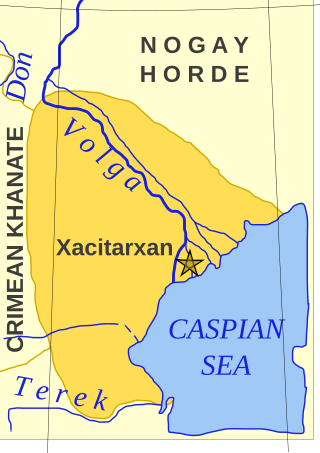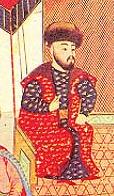Related Research Articles

The Tatars, formerly also spelt Tartars, is an umbrella term for different Turkic ethnic groups bearing the name "Tatar" across Eastern Europe and Asia. Initially, the ethnonym Tatar possibly referred to the Tatar confederation. That confederation was eventually incorporated into the Mongol Empire when Genghis Khan unified the various steppe tribes. Historically, the term Tatars was applied to anyone originating from the vast Northern and Central Asian landmass then known as Tartary, a term which was also conflated with the Mongol Empire itself. More recently, however, the term has come to refer more narrowly to related ethnic groups who refer to themselves as Tatars or who speak languages that are commonly referred to as Tatar.

The Golden Horde, self-designated as Ulug Ulus, was originally a Mongol and later Turkicized khanate established in the 13th century and originating as the northwestern sector of the Mongol Empire. With the division of the Mongol Empire after 1259, it became a functionally separate khanate. It is also known as the Kipchak Khanate or as the Ulus of Jochi, and it replaced the earlier, less organized Cuman–Kipchak confederation.

Sultan Giyasuddin Muhammad Uzbek Khan, better known as Uzbeg, Uzbek or Ozbeg (1282–1341), was the longest-reigning khan of the Golden Horde (1313–1341), under whose rule the state reached its zenith. He was succeeded by his son Tini Beg. He was the son of Toghrilcha and grandson of Mengu-Timur, who had been khan of the Golden Horde from 1267 to 1280.

The Crimean Khanate self-defined as the Throne of Crimea and Desht-i Kipchak and in old European historiography and geography known as Little Tartary, was a Crimean Tatar state existing from 1441–1783, the longest-lived of the Turkic khanates that succeeded the empire of the Golden Horde. Established by Hacı I Giray in 1441, it was regarded as the direct heir to the Golden Horde and to Desht-i-Kipchak.

The Khanate of Astrakhan, also referred to as the Xacitarxan Khanate, was a Tatar state that arose during the break-up of the Golden Horde. The Khanate existed in the 15th and 16th centuries in the area adjacent to the mouth of the Volga river, around the modern city of Astrakhan. Its khans claimed patrilineal descent from Toqa Temür, the thirteenth son of Jochi and grandson of Genghis Khan.

Ghabdellatif or Abdullatif was the Khan of the Kazan Khanate from 1496 to 1502.
Hacı I Giray was the founder of the Crimean Khanate and the Giray dynasty of Crimea. As the Golden Horde was breaking up, he established himself in Crimea and spent most of his life fighting off other warlords. He was usually allied with the Lithuanians. His name has many spellings, such as Haji-Girei and Melek Haji Girai.

Devlet I Giray ruled as Crimean Khan during a long and eventful period marked by significant historical events. These events included the fall of Kazan to Russia in 1552, the fall of the Astrakhan Khanate to Russia in 1556, and the burning of Moscow by the Crimean Tatars in 1571. Another notable event during Devlet's reign was the defeat of the Crimeans near Moscow in 1572. However, Cossack raids into the Crimea were also common during his reign.

The Great Horde was a rump state of the Golden Horde that existed from the mid-15th century to 1502. It was centered at the core of the Golden Horde at Sarai. Both the Khanate of Astrakhan and the Khanate of Crimea broke away from the Great Horde throughout its existence, and were hostile to the Great Horde. The defeat of the forces of the Great Horde at the Great Stand on the Ugra River by Ivan III of Russia marked the end of the "Tatar yoke" over Russia.

Meñli I Giray was the khan of the Crimean Khanate and the sixth son of Hacı I Giray.
The Muscovite–Lithuanian Wars were a series of wars between the Grand Duchy of Lithuania, allied with the Kingdom of Poland, and the Grand Duchy of Moscow, which was later unified with other Russian principalities to eventually become the Tsardom of Russia. After several defeats at the hands of Ivan III and Vasily III, the Lithuanians were increasingly reliant on Polish aid, which eventually became an important factor in the creation of the Polish–Lithuanian Commonwealth. Before the first series of wars in the 15th century, the Grand Duchy of Lithuania controlled vast stretches of Eastern European land, from Kiev to Mozhaysk, following the collapse of Kievan Rus' after the Mongol invasions. Over the course of the wars, particularly in the 16th century, the Muscovites expanded their domain westwards, taking control of many principalities.

The Battle of Kletsk was fought on 5 August 1506 near Kletsk, between the Grand Ducal Lithuanian army, led by Court Marshal of Lithuania Michael Glinski, and the army of the Crimean Khanate, led by Fetih I Giray and Burnaş I Giray, sons of the Khan of Crimea, Meñli I Giray. The battle was one of the first and greatest Lithuanian victories over the Tatars.

Ahmed Khan bin Küchük was the Khan of the Great Horde from 1465 to 1481.
Mahmud Astrakhani was one of Küchük Muhammad's sons and a Khan who founded the Khanate of Astrakhan in the 1460s.
Nur Devlet Giray, was a khan of the Crimean Khanate and the son of Hacı I Giray, the founder of Crimean Khanate.
The Battle of Olshanitsa was fought on January 27, 1527, between the armies of the Grand Duchy of Lithuania and Crimean Khanate. It was the last large raid into the Grand Duchy. It was also the last large victory of the Great Hetman Konstanty Ostrogski before his death in 1530.

The Lithuanian-Muscovite War of 1487–1494 was the war of the Principality of Moscow, in alliance with the Crimean Khanate, against the Grand Duchy of Lithuania in alliance with the Golden Horde Khan Akhmat, united by personal union. Kingdom of Poland under the leadership of Grand Duke Casimir IV Jagiellon.